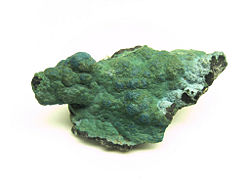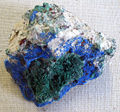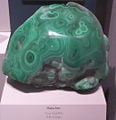Malachite
This article is about the mineral. For the butterfly see Malachite (butterfly). For the Jinn single see Malachite (Jinn).
| Malachite | |
|---|---|
 Malachite showing typical radiating fiberous and botryoidal structure. |
|
| General | |
| Category | Mineral |
| Chemical formula | Cu2CO3(OH)2 |
| Identification | |
| Color | Green |
| Crystal habit | Massive, botryoidal, stalactitic |
| Crystal system | Monoclinic - prismatic |
| Cleavage | Perfect |
| Fracture | Conchoidal to splintery |
| Mohs Scale hardness | 3.5 - 4 |
| Luster | Dull/vitreous in large quantities, silky in crystal form |
| Streak | green |
| Specific gravity | 3.6 - 4 |
| {{{density}}} | |
Malachite is a carbonate mineral, copper(II) carbonate hydroxide Cu2CO3(OH)2. It crystallizes in the monoclinic crystal system, and most often forms botryoidal, fibrous, or stalagmitic masses. Individual crystals are rare, but do occur as slender to acicular prisms. Pseudomorphs after more tabular or blocky azurite crystals also occur.
Malachite often results from weathering of copper ores and is often found together with azurite (Cu3(CO3)2(OH)2), goethite, and calcite. Except for the vibrant green colour, the properties of malachite are very similar to those of azurite and aggregates of the two minerals together are frequently found, although malachite is more common than azurite. Typically associated with copper deposits associated with limestones, the source of the carbonate.
The stone's name derives (via Latin and French) from Greek molochitis, "mallow-green stone", from molochē, variant of malachē, "mallow". Malachite was used as a mineral pigment in green paints from antiquity until about 1800. The pigment is moderately lightfast, very sensitive to acids and varying in colour. The natural form was being replaced by its synthetic form, verditer amongst other synthetic greens. It is also used for decorative purposes, such as in the Malachite Room in the Hermitage which features a huge malachite vase. "The Tazza", one of the largest pieces of malachite in North America and a gift from Tsar Nicholas II, stands as the focal point in the center of the room of Linda Hall Library.
Large quantities of malachite have been mined in the Urals. It is found in the Democratic Republic of Congo; Tsumeb, Namibia; Ural mountains, Russia; Mexico; Broken Hill, New South Wales; England; Lyon; and in the Southwestern United States especially in Arizona at Bisbee and Morenci.
In Israel, malachite is extensively mined at Timna, often called King Solomon's Mines. Archeological evidence indicates that the mineral has been mined and smelted at the site for over 3,000 years. Most of Timna's current production is also smelted, but the finest pieces are worked into silver jewelry.
Images
Malachite from the Democratic Republic of Congo
ReferencesISBN links support NWE through referral fees
- Hurlbut, Cornelius S.; Klein, Cornelis, 1985, Manual of Mineralogy, 20th ed., John Wiley and Sons, New York ISBN 0-471-80580-7
- Mineral Galleries
- Webmineral data
- Mindat
- Virtual tour of the Malachite Room
br:Malakit ca:Malaquita de:Malachit et:Malahhiit es:Malaquita fr:Malachite ko:공작석 it:Malachite he:מלכיט lt:Malachitas hu:Malachit nl:Malachiet ja:孔雀石 pl:Malachit pt:Malaquita ru:Малахит sk:Malachit sl:Malahit fi:Malakiitti sv:Malakit vi:Malachit tr:Malahit zh:碱式碳酸铜




